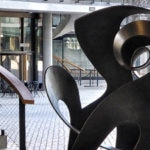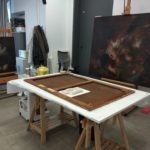Caring for Art: Conservation and Restoration of the BBVA Collection
There is no greater witness to history than art. Present in all eras and cultures, artisticcreations have come down to our day filled with esthetic and documentary value. For that reason, the work at the BBVA Collection has very little to do with finance. It consists of caring for art, in order to preserve our history.

In 2013, the BBVA Collection contracted a team of restorers to insure that the 7,000 pieces that comprise the bank´s artistic patrimony - paintings, works on paper, sculptures and decorative art – are cared for by professionals.
In spite of being expert restorers, this team makes every effort never to have to prove it. “Preventive conservation is very important, in order not to have reach the point where the artworks have to be restored,” explains María Luisa Barrio, Head of BBVA´s Historical-Artistic Patrimony.
Preventive conservation is a continuous, comprehensive task that protects works of art from the effects of environmental conditions. For that reason, it requires studying every detail of the place where each work is kept. The temperature should be maintained at between 18 and 22 degrees Celsius (64.4 to 71.6 degrees Fahrenheit) and the atmospheric humidity between 45% and 55%, with a minimum variation, depending on the material in question. The third factor is light; although essential for viewing artworks, light is also the one of the primary contributors to their deterioration. “The most important thing is that there not be great fluctuations in temperature and humidity, that they be kept stable, because sudden changes are what do the most damage to a work of art. A frame could come loose or paint could peel off,” explains María García-Frías, Head of Restoration.

BBVA's Colletion restoration workshop - BBVA
Scientific testing before an intervention
Restoring a work of art is a delicate task. Dressed like surgeons in white lab coats and gloves, the experts at the BBVA Collection perform all sorts of operations. The cleaning of superficial dirt, settling of color, repair of damage to frames, or lightening of altered varnishes, are some of the most frequent procedures.
But before beginning the treatment, it´s necessary to make a diagnosis of the piece. Thanks to prior studies, chemical analyses and x-rays of a painting, it’s possible to know the secrets and the history of the work. In this “artistic pre-operative procedure,” the restorers can learn, for example, what the original colors were and the modifications that have been made to them over time.
The experts repair, to the extent possible, all the damages that a painting has suffered, including that which has come from unfortunate interventions made by their colleagues in the past. The advanced technology available to María García-Frías and Beatriz Lahoz, restorers of paintings at the BBVA Collection, enables them to work with a degree of precision that would have been unimaginable only a few years ago.

Before and after of Carlos III's picture - Colección BBVA
Sculptures exposed to the sun and rain
Three-dimensional art plays an important role in the BBVA Collection. In its workshops, sculptures from the 15th Century to the present have been rescued and restored.
The 20th Century poses a particular challenge because it was a totally experimental age in art. “The good thing is that some of those artists are still alive and we can contact them so they can explain to us the creative process, and we can do an appropriate restoration,” says María José Salas, a restorer of sculpture and frames. This is the case of “El devenir” (“The Transformation”), by Andreu Alfaro, one of the sculptures that graces Ciudad BBVA in Madrid. The assistant to the artist was the one in charge of making the replicas of the pieces that were broken.
Conservation takes on particular importance in these works, especially when they have been displayed outdoors; sculptures that have been exposed to rain, cold and heat, need continuous care. The restorers are in charge of applying the necessary coatings so that neither the winter nor the summer will change the sculptures’ condition and form.
Particularly striking is the restoration of a sculpture by José Luis Fajardo that is currently on display in the cafeteria on the 11th floor of La Vela, the oval-shaped building that towers over BBVA City in Madrid. María Álvarez, a restorer of sculpture and frames, recalls that when they found it in one of the Collection’s warehouses, the aluminum sculpture had the marks from aggressive cleaning, scratches and even swastika graffiti. “We had to do a restoration that was quite invasive and we even proposed polishing the work completely,” she says. The final result is surprising, to say the least.

José Luis Fajardo's sculpture - BBVA
Acid, the greatest enemy of paper
The BBVA Collection contains many valued works on paper, from 15th Century promissory notes to pieces signed by artists such as Joan Miró or Miquel Barceló. Acid is their greatest enemy, according to Lludmila Lidón and Marta García, two restorers specialized in caring for these jewels on paper.
“Acid breaks down the fibers that make up the paper, so that over time, the work is destroyed. That´s why it’s necessary to store them in folders made of PH-neutral materials that keep them separate from other elements that could transmit acidity,” they explain.
Framing is another problem they have to face. Lidon and García often find themselves with artworks that have been framed with materials or adhesives of very poor quality, which have damaged the pieces. Paper, which in itself is fragile, weakens when it is mounted in unsuitable frames or with adhesives that are too acidic.
For cleaning paper, there´s nothing better than a bath with water. It eliminates dirt, combats high levels of acidity and manages to recover the original color of the material. However, even water can be aggressive, since it can tear down some of paper’s natural qualities.
Watches, tapestries and furniture
Eighteenth-century watches, extraordinary tapestries with historic, religious or hunting scenes, artisanal furniture from the far corners of the world, spyglasses, lamps and a variety of artifacts populate the workshop of María Rotaeche and Patricia Baigorri, two restorers of decorative art.
Among the objects is a piece that invariably strikes the attention of anyone who enters the workshop: an 18th-Century Chinese lacquered cabinet with drawers and panels that simulate the structure of an oriental temple, columns and staircases included. The gold and silver tones are now returning to a piece of furniture whose time-worn beauty has been recovered, thanks to the patience and skill of this pair of restorers.
The serenity and professionalism with which María and Patricia treat pieces from such a wide variety of epochs, styles and materials, are qualities shared by the entire team. Without regard for their individual disciplines, the restorers have been working for seven years, chisel or brush in hand, with the same goal: to preserve and care for the artistic patrimony of the bank. In this time, they have managed to gather, under the name of the BBVA Collection, creations of special interest and great artistic value.